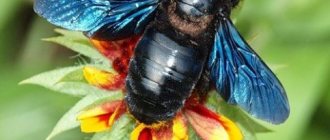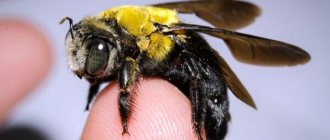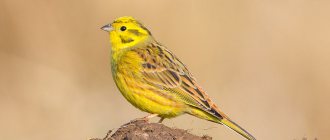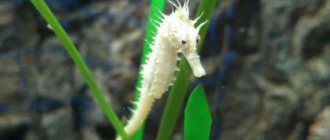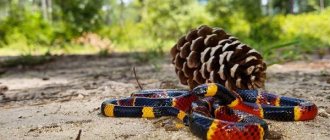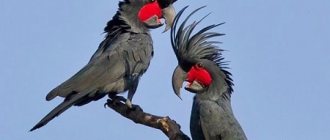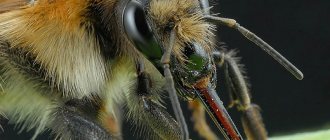The purple carpenter bumblebee, which has a spectacular appearance, belongs to the genus of carpenter bees, that is, insects that build their nests in the remains of tree species. These can be buildings, poles, fences, bamboo. The Latin name for the purple bumblebee is Xylocopa violacea. Refers to relict insects, that is, preserved from prehistoric times. This species has existed since the Paleogene.
Description, appearance and characteristic features
The black carpenter bumblebee is a solitary insect from the genus of carpenter bees. This is a relict insect that existed on Earth in prehistoric times. Its appearance differs from the usual bee appearance. The carpenter bumblebee is a black insect with a blue tint on the abdomen and head and blue-violet wings. Due to the active work of its wings, when a bumblebee flies, it seems that it is purple. The head is massive with a powerful jaw, large eyes, long black antennae with red spots at the ends.
Representatives of this species are among the largest among the entire family. The body size of an adult reaches 3 cm. The insect has heavily pubescent legs, but the hairs on the body are sparse. Due to this, the body looks smooth and glossy.
Appearance
Selection
The genus Xylocopa also includes insects with altruistic behavior. The female guarding the nest may die. However, females of the species Xylocopa Sulcatipes and Pubescens are distinguished by altruism: having found an abandoned nest, these bees begin to take care of it.
Xylocopa Pubescens
This option is not typical for Valga and Violacea species.
When a nest is not guarded, it may be occupied or destroyed. And the Pubescens and Sulcatipes species are less vulnerable, which contributes to the variability of these bees.
Lifestyle and habitat of carpenter bumblebees
The carpenter bumblebee is a heat-loving insect, this explains its habitat, which includes:
- Southern Europe;
- Near East;
- Türkiye;
- southern and western regions of Russia;
- Ukraine;
- Belarus;
- Crimea;
- Caucasus.
The bumblebee summer begins in mid-spring and lasts until the end of September. Insects make nests in wood. These could be dried tree trunks or branches, poles, or wooden buildings. Insects gnaw passages up to 30 cm long, in which they form a dwelling of 10 - 12 adjacent cells. The partitions between the cells are made of wood chopped by a bumblebee.
Carpenter bumblebees prefer to settle in open spaces, always choosing the sunny side. Insects live either alone or in small colonies consisting of only females, preferring silence and solitude. They settle in the vicinity of people only out of necessity, when there is no other suitable place nearby for housing and building a nest.
Behavior
The purple bee begins to fly from mid-April. The flight ends around the end of September. As a habitat and for breeding offspring, the purple bumblebee chooses typical carpenter's places: fence posts, utility poles, dry tree trunks, rocks, abandoned rodent holes. Prefers open places: near populated areas, on the edge of the forest.
In any habitat, choose the sunny side, not the shade. The purple bee chooses a location next to a person not because of its proximity (it prefers privacy), but because of the abundance of suitable materials for building nests.
Over thousands of years of coexistence with humans, purple carpenter bees have developed certain habits. Sometimes you can see them inspecting panel or concrete houses. They are looking for a suitable rotted beam or ceiling. Human activity forces them to such searches. Forestry departments clear forests of dead wood, sanitary felling deprives carpenter bees of the opportunity to quickly find suitable housing.
New generations of bumblebees are in no hurry to leave their father’s house for good: up to 10 generations can live in one nest or until the wood deteriorates. The food of adult purple bees is nectar and plant pollen.
Nutrition and reproduction
Black bumblebees look for mating partners in the spring. At this time, males attract the attention of females with a loud buzzing. One male can fertilize up to 5 females. After this, the female looks for a suitable place to live. Having found it, it first gnaws through a fairly long horizontal tunnel the width of an adult’s finger, and then turns down and gnaws through the cells.
The female fills each cell with pollen, then places an egg there and seals it with a dense sticky mass consisting of wood dust and her own saliva. Having filled all the cells, the female seals the entrance to the nest. The hatched larvae grow and develop inside their cell. They pupate in it and the imago emerges from the cocoon. Young bumblebees spend the winter in the nest, and in the spring they gnaw a way out and get out.
Adult purple carpenter bumblebees feed on pollen and nectar; the larvae have enough reserves left by the female in the cell with the egg.
Character
To distinguish a female from a male, look at the antennae. In males, the last two segments are red, and the last one is also curved. Gray hair on the back is also a sign of a male. He has no sting.
A real male
The venom of solitary bees differs little from the venom of honey bees:
- The pH reaction is acidic (soda, etc. is used for removal);
- The poison contains both histamine and allergen protein (in small quantities);
- The sting of any tree bee is more painful than the stings of ordinary bees. The poison contains paralytic substances and shock is possible. A bite to the throat is always fatal.
The effect of histamine is severe swelling, and when the poison is carried by the blood, the skin becomes covered with spots. Need ice.
Female tree bees are aggressive in May. But in general the level of aggression is low.
Those who wave their arms are the ones who get stung. By the way, you can run away.
Any “nest shoot” contains 10-12 cells with brood. The number of colonies, accordingly, can reach two to three dozen individuals!
Apiary on the hill
Mating behavior resembles that of birds:
- The male chooses some kind of elevation - a hill, the space above the crown of a tree, etc.;
- The area above the hill will be patrolled;
- Sooner or later one of the females will be within the territory.
Any of the nests, if it is not preserved, is guarded by at least one female. If a xylocop is stung, it means there is a nest nearby.
The food source for all tree bees is nectar and pollen. They do not attack hives, but they are attracted by white, blue and yellow colors. It is impossible to breed “carpenters”: there is no attachment to the place, to the nest. Attacks on people are rare. But if you crush or hit a bee, it will sting.
Flights continue from April-May until October.
How dangerous is a tree bumblebee bite?
Although the blue bumblebee is not usually aggressive, it may still sting a person, for example if it is frightened, feels threatened, or is defending a nest. The main danger of a bumblebee bite is a toxic substance that enters the bloodstream at the time of the bite and quickly spreads throughout the body.
In most cases, the problem is treated with only pain and slight swelling. But depending on the location of the bite and the state of the person’s immune system, the consequences can be much more severe.
Rules for dealing with a carpenter bumblebee bite
Due to their dark color, menacing buzzing and somewhat ponderous flight, carpenter bumblebees appear huge and dangerous. Therefore, the bite of such an insect immediately causes panic, which is only aggravated by pain and rapidly developing swelling in the affected area. The most important thing is to calm down, act quickly and take all possible measures to avoid unpleasant consequences.
Bite
Symptoms of a bumblebee bite
The main symptoms of a black bumblebee bite are not much different from the symptoms of the bite of any stinging insect. After a bumblebee stings, the following appears:
- sharp pain, burning;
- skin redness;
- swelling;
- seals at the site of the bite;
- increase in temperature of the affected area.
Symptoms appear very quickly, but how long they last depends on the individual characteristics of the person. For some, recovery takes a few hours, for others it takes weeks.
First aid
To reduce pain and swelling, as well as prevent the development of serious consequences, competent first aid is necessary after a black bumblebee bite. It is as follows:
- wash the wound;
- treat the bite site with an antiseptic;
- apply a cold compress;
- take an antihistamine;
- drink a lot of clean water to quickly remove toxins from the body.
Do not scratch the wound, cauterize it, or try to squeeze out the poison. If the stung person’s health worsens, you should immediately seek medical help.
Consequences and allergic reaction
The main negative consequences after a bumblebee bite are associated with the development of allergies. In some people, the immune system reacts very actively to a toxin that has entered the blood. This may be expressed by the following symptoms:
- severe redness and extensive swelling, spreading far beyond the boundaries of the affected area;
- rash on the body;
- nausea, vomiting, diarrhea;
- weakness, dizziness;
- labored breathing;
- rapid or too slow pulse;
- high temperature, fever, chills.
In severe cases, convulsions, loss of consciousness are observed, and the likelihood of anaphylactic shock is high.
Prevention of attacks
To avoid a bumblebee attack, just follow simple rules:
- do not walk on the grass barefoot;
- do not make sudden movements to drive away the insect;
- Do not use perfume with a strong odor.
Well, of course, you shouldn’t try to destroy a bumblebee nest.
Popular varieties of black bees
Highly social bees are considered separately. This group differs not only in behavior and structure, but also in its body structure.
- Ordinary. The insect is very similar in color to a wasp. The black insect is small in size and not aggressive; the wasp is more irritated. Yellow and black stripes can be seen on the body. They build underground passages.
- Honey-bearing. They accumulate a large amount of honey in the honeycombs; they are small in size, black in color, and have brown and yellow stripes on the belly. Beekeepers breed these bees to produce large quantities of honey. Such bees can be different, there are black and white, pure black. They all differ in their feeding habits - they prefer different nectar, and also differ in their lifestyle - you can find semi-social, social and solitary bees. If you keep a black breed, you need to take care of protection. Such a bee is very painful to bite. Some sting several times, so the skin becomes irritated.
- Public. Insects can be of three types: bumblebees, stingless bees, and honeybees. They all have common characteristics, differences in color and behavior. They are divided into two groups - black and brown. Can be found in Great Britain, Europe, North Africa, America.
Black insects can be divided into Dutch and heather insects. The Americans brought them from Holland. Such bees are clever thieves. A positive quality is their productivity - they collect a sufficient amount of dark-colored honey in a short time; buckwheat is used for this. They are characterized by increased nervousness. When the hive opens, they can rush around wildly. After the beekeeper has taken out the frame, they hang in clusters, only then they begin to fall and run in different directions. In this situation, it is impossible to quickly find the queen.
The black American bee constantly stalks the beekeeper in the apiary. Tends to swarm. Has a white signet. Such insects are easily shaken off the honeycomb when the frames are removed. In some situations you are calm. They are dangerous when they get under clothing and severely sting the beekeeper.
The black North African bee is especially dangerous; it is irritable and can smear everyone with red propolis. Exists in Algeria, Morocco, Tunisia. The breed is very angry, irritable, when the nests are inspected, it begins to hang in clusters. They have a wide belly and slight fluff. The length of the proboscis reaches about 6.5 mm. Bees are fertile; after they lose their queen, the bees begin to lay eggs.
The dark European bee originated from this breed, so the French insects have a large number of characteristics, the same as those of the North African ones. Twice a year, families are actively involved in raising brood; this happens in the autumn and spring. The beekeeper must take into account that insects are restless at this time and may leave brood and food. At the same time, they are resistant to diseases such as nosematosis and European foulbrood.
The Sicilian bee is also black in color, of North African origin, and this breed never steals honey. Sicilian bees are small in size, with yellow spots in some situations. The African mountain bee is pure black without yellow spots, is distinguished by its peaceful nature, large size, and has a very long proboscis.
In nature, there are a large number of different black bees, all of them differ in the following characteristics: size, lifestyle, natural functions, productivity. Each breed makes some contribution to nature, therefore it is protected by the Red Book and nature reserves. Beekeepers breed only honey insects adapted to their area.
https://youtube.com/watch?v=hxxdxSANnMI
How to get rid of it?
If a black bumblebee is circling and buzzing threateningly near your house, there is no need to panic. Most likely he ended up here by accident and will fly away very soon. If insects have chosen one of the buildings or a tree on the site, measures need to be taken.
To begin with, you should try to get rid of insects using gentle methods. You can, for example, use the fact that carpenter bumblebees, like all bees, have a negative attitude towards loud sounds. By placing speakers on the street and regularly turning them on at full volume, it is quite possible to drive away unwanted neighbors.
Mint
Another option is to plant plants in the area whose smell bumblebees do not like, such as garlic or mint. Smoke bombs will also help drive away insects.
The following methods are used to exterminate bumblebees:
- traps (homemade from a wooden box and a plastic bottle or purchased with ultrasonic lamps);
- treating the nest and the space around it with essential oils, infusions of mint, lavender, thyme, and onion;
- filling the nests with machine oil, diesel fuel, gasoline, and soap solution.
To prevent the appearance of carpenter bumblebees, all wooden surfaces should be treated with varnish, paint or special impregnation.
Attention! As is known, bumblebees do not make nests in treated wood.
